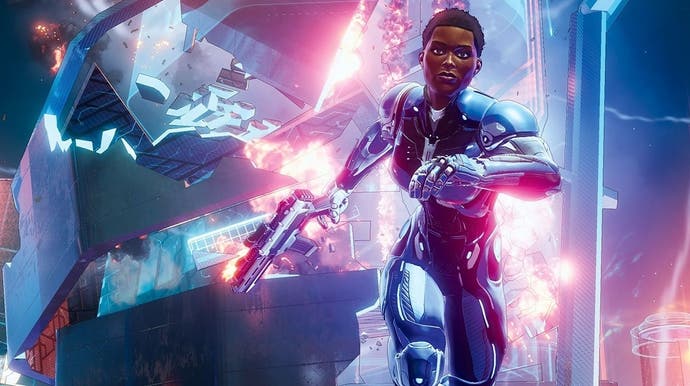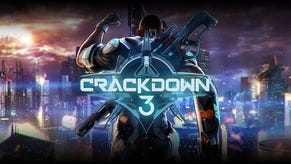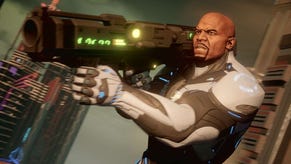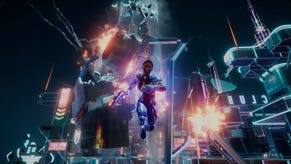Crackdown 3 Wrecking Zone: what happened to the 'power of the cloud'?
Destruction derby.
What happened to the power of the cloud? Crackdown 3 finally launched last week, its Wrecking Zone multiplayer mode presenting the final iteration of an astonishing cloud-driven physics showcase first revealed by Microsoft in 2015. Perhaps inevitably, the final game only bears a passing resemblance to that initial demo, and while Wrecking Crew itself is rich in potential, the actual game is rather lacklustre.
Of course, the story of Xbox One's pioneering cloud gaming system goes back all the way to 2013, before the system even launched. In the wake of an underwhelming, TV-centric reveal and a palpable specs disadvantage against PlayStation 4, Microsoft surprised us by revealing that Xbox One could interface with its Azure cloud infrastructure. There was talk of Xbox Live upgrades to 300,000 servers to enable this revolution, and even mention of 3x the compute power in the cloud available to every Xbox console at any given point. Looking back at the last five years of Xbox One releases, the claims look almost ludicrous now and it's safe to say that we've yet to encounter a single release on the system that offers any kind of cloud-powered advantage over PlayStation 4.
Once the generation kicked in properly, claims surrounding the power of the cloud began to fade into the background. Respawn's Titanfall ran some drone AI on its servers when it launched in March 2014, but it's difficult to square what is effectively a dedicated server for an FPS with the game-changing power apparently offered by cloud technology. Remarkably though, the 2015 Crackdown demo - embedded on this page and witnessed by our own John Linneman - actually saw Microsoft double down on the cloud's potential. The demo itself didn't run particularly well and ran at a low resolution, but the scale of the ambition on display here is staggering.
The demo kicks off with a cool demonstration of micro-detail chip damage, with the player able to use his gun to punch a hole through a wall - which can then be used for sniping. Dynamic debris is generated that accumulates on the floor during this process. However, the demo's most spectacular moments come when blasting through the lower levels of a tower block - the skyscraper collapses realistically into another building, resulting in a cascade of destruction, both structures reduced to their component parts. In the wake of the carnage, a debug camera scans across the wreckage. It's incredible. Three-and-a-half years on, it still looks like nothing we've ever seen - certainly not from the final rendition of Crackdown 3.
What Wrecking Zone delivers is still impressive in many respects, but is definitely a simplification of the original demo - a situation which looks like a combination of both technological limitations and gameplay considerations. To begin with, the cityscape of the original demo becomes a series of enclosed holodeck-esque arenas - high on verticality, but small in terms of their overall footprint. What's clear from the 2015 demo is that it's exactly that - a demonstration, with no real gameplay as such. Limiting the scale of the play space means that players can actually find one another, which definitely helps, but there's still the sense that there's not much to actually do. The destruction can look wonderful, but little of the gameplay is actually built around the concept.
Technologically, the cutbacks are legion. Micro-scale chip damage is completely absent, while destruction generally is far less granular, with buildings and statues breaking apart into more simplistic polygonal chunks. It's interesting to stack up Wrecking Zone with Red Faction Guerrilla Remastered - a game we sorely regret not covering at the time of its launch. Originally a last-gen Xbox 360 title, it does many of the same things as Wrecking Zone - on a smaller scale definitely, but with more granularity and detail. And this raises the question of whether the cloud would actually be necessary at all for Wrecking Zone.
We went looking for answers by running Xbox One X and Xbox One S simultaneously in the same game instance - no mean feat bearing in mind Wrecking Zone's current lack of party support. We managed to get two players into the same game by setting up a party regardless, and using voice chat to synchronise our entry into general matchmaking. Four times out of five, we ended up in the same game - albeit on opposing teams. Regardless, this enabled us to compare how the destruction is rendered on each system, and the physics are perfectly replicated on each console, certainly in terms of the primary 'chunks' generated when splitting an object apart - and in how they react. Micro debris does seem to be dynamically generated on the system, but there is no smoke and mirrors here - Wrecking Zone is presenting a lot of destruction pretty much identically across all participating consoles.
There are performance problems, but they do not seem to be related much to the physics side of the equation. Like the single-player portion of the game, Wrecking Zone runs at 30 frames per second throughout, though the impression is of a far less consistent experience, owing to inconsistent frame-pacing - something that doesn't impact the campaign. Occasional stutter also presents, perhaps down to what the game occasionally flagged to tell us was a poor connection (we ran the game on a UK fibre line). Wrecking Zone does include a motion blur option - not fully enabled in the standard game - which helps to smooth over the jerkiness a tad, but hopefully the 30fps delivery can be properly addressed.
Beyond that, Wrecking Zone needs a lot of work to transform itself from an interesting tech demo into a fully realised multiplayer game. Lack of party support is being addressed, and having played with John Linneman on the same server, there's rich potential here in collaborating with teammates in ripping the environment down - not that this is really a primary element of the game's objectives right now. Perhaps the biggest disappointment isn't really the technology at all, but rather the lack of meaningful things to do, and how the destruction is more like window dressing rather than being essential to the flow of the action. The shooting mechanic also seems rather unfinished - the auto lock-on from the campaign manifests in Wrecking Zone, and not even breaking line of site disrupts it. As such, shooting lacks skill, and avoiding an opponent who has already got a lock-on is harder than it should be.
It's difficult to avoid the conclusion that the original Crackdown 2015 concept we saw was massively over-engineered in some respects - to the point where actually rolling it out to thousands of players could ever be achieved, bearing in mind the vast amounts of compute power it required. Meanwhile, the size of the environment, the limited numbers of players and the fact that the city was otherwise empty clearly limits the type of game that could actually be delivered. Microsoft also had something of a messaging problem here. In the 2015 demo, the firm made it clear that the destruction wouldn't be a part of the single-player game - yet based on the reaction to our video coverage last week, much of the audience didn't seem to know that. Perhaps more telling is that right up until the arrival of review code, we had little idea of what Crackdown 3 would actually deliver.
From our perspective, perhaps the most important cut-back to Crackdown 3 has nothing to do with either Wrecking Zone or the 2015 demo, but rather the provision of campaign co-op. First of all, we rather like Crackdown 3's single-player mode and the two-player co-op that is there is great fun to play. Performance is only mildly lower than offline play, and being able to drop in on your friend's campaign to help out is just as much fun as it was in the original game. The regret here is that it is just a two-player mode, without the support for four players as was originally promised. The action scales beautifully with two players on the field, and would have been epic with an entire squad in play. Interestingly, the cloud does seem to be involved in co-op, running the world simulation and synchronising it for both players - and just like Wrecking Zone, the synchronisation is very accurate. Right now, a limitation where the PC version locks to 30fps in co-op play is a disappointment, but the developers say it will be patched.
Ultimately though, Crackdown 3 doesn't deliver much of the promise previously showcased from the power of the cloud. What players do get is a highly entertaining co-op experience and a disappointing, but still interesting tech demo in the form of Wrecking Zone. Across the whole generation, the most ambitious uses of server-side technology have mostly been seen in maintaining and synchronising larger multiplayer games, with very few of the concepts Microsoft initially discussed coming into focus in final games.
So with that in mind, was the initial pitch in 2013 a desperate gambit from Microsoft to challenge PS4's specs advantage? Or, like the Crackdown 3 2015 demo, was turning highly promising tech demos into fully realised games more challenging than originally thought? Looking back at the messaging of the time, it's difficult to avoid a sense of hyperbole in the pitch, and whether it's down to latency issues, varying levels of user bandwidth, or the sheer logistics of coping with a vast userbase, cloud gaming as Microsoft defined it back in 2013 failed to happen.
You can't keep a good idea down, however, and perhaps Microsoft's mammoth Azure datacentre infrastructure will deliver new opportunities for gaming - just not in the way it was previously marketed. With Project xCloud, Microsoft is aiming to revolutionise how games are accessed as opposed to enhancing the content within them. The idea is to remove console - or even TV - ownership as a barrier for entry to the Xbox ecosystem, with the system library available through a range of devices including smartphones and tablets. We're one or two key technological innovations away from a 'gameplay over IP' system that truly delivers, but Microsoft is aware of the challenges and we're looking forward to seeing what solutions the Xbox engineers come up with.





.jpg?width=291&height=164&fit=crop&quality=80&format=jpg&auto=webp)













